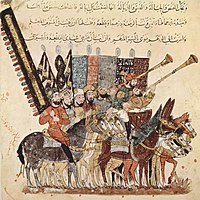
Back مقامة Arabic Məqamə Azerbaijani Maqama Catalan Makame German Maqama Spanish مقامه Persian Maqâma French מקאמה HE Makáma Hungarian Մակամա Armenian

The maqāma (Arabic: مقامة [maˈqaːma], literally "assembly"; plural maqāmāt, مقامات [maqaːˈmaːt]) is an (originally) Arabic prosimetric literary genre of picaresque short stories originating in the tenth century C.E.[1][2] The maqāmāt are anecdotes told by a fictitious narrator which typically follow the escapades of a roguish protagonist as the two repeatedly encounter each other in their travels. The genre is known for its literary and rhetorical complexity, as well as its alternating use of rhymed verse with a form of Arabic rhymed prose known as saj’.[3] The two most well-known authors within the genre are Badī' al-Zaman al-Hamadhāni, one of its earliest exponents, and al-Harīrī of Basra, whose maqāmāt are commonly held responsible for the genre's rise in popularity from the eleventh century onward.[4] Interest in al-Hariri's Maqāmāt spread throughout much of the Islamic Empire, with translations and original works appearing in Hebrew, Syriac and Persian.[5] Many authors still contribute to and draw inspiration from the literary genre of Maqāma to this day.[3]
Professionally illustrated and calligraphed manuscripts were produced for private use. Of these manuscripts, only 11 surviving copies are known to exist; all of them are of al-Harīrī's Maqāmāt, and none are from before the thirteenth century C.E.[6] These illustrations tend to be colored linework on a white background; they often depict the narrator and protagonist's escapades together, and so most of these compositions (unlike much of medieval Islamic Art) primarily feature human figures with notably expressive faces and gestures.[7] The illustrated manuscripts made extensive use of captions, likely added after the manuscripts' completion to provide key context to the illustration or to provide information that could not be gleaned from the illustration alone.[8] Art found in the illustrations of al-Harīrī's Maqāmāt appears to include borrowed visual motifs from medieval Christian and Judaic art as well as references to architecture found within the Islamic empire.[9] In addition, the illustrations tend to share formal qualities with the art of shadow play.[10]
- ^ Meisami, J.S.; Starkey, Paul (1998). Encyclopedia of Arabic Literature, vol. 1. Routledge. pp. 54–56. ISBN 0415185718.
- ^ Qian, A. (2012). The Maqāmah as Prosimetrum: A Comparative Investigation of its Origin, Form and Function [Unpublished doctoral dissertation]. University of Pennsylvania.
- ^ a b Omri, Mohamed-Salah (2008). "Local Narrative Form and Construction of the Arabic Novel". NOVEL: A Forum on Fiction. 41 (2/3): 244–263 – via JSTOR.
- ^ Beeston, A.F.L. (1971). "The Genesis of the Maqāmāt Genre". Journal of Arabic Literature. 2: 1–12 – via JSTOR.
- ^ Meisami, Julie Scott; Starkey, Paul, eds. (1998). Encyclopedia of Arabic literature. London ; New York: Routledge. p. 507. ISBN 978-0-415-18571-4.
- ^ George, A. F. (2012). Orality, Writing and the Image in the Maqāmāt: Arabic Illustrated Books in Context. Art History, 35(1), 10–37. https://doi.org/10.1111/j.1467-8365.2011.00881.x
- ^ Cite error: The named reference
:22was invoked but never defined (see the help page). - ^ Cite error: The named reference
:4was invoked but never defined (see the help page). - ^ Cite error: The named reference
:9was invoked but never defined (see the help page). - ^ Cite error: The named reference
:10was invoked but never defined (see the help page).
© MMXXIII Rich X Search. We shall prevail. All rights reserved. Rich X Search